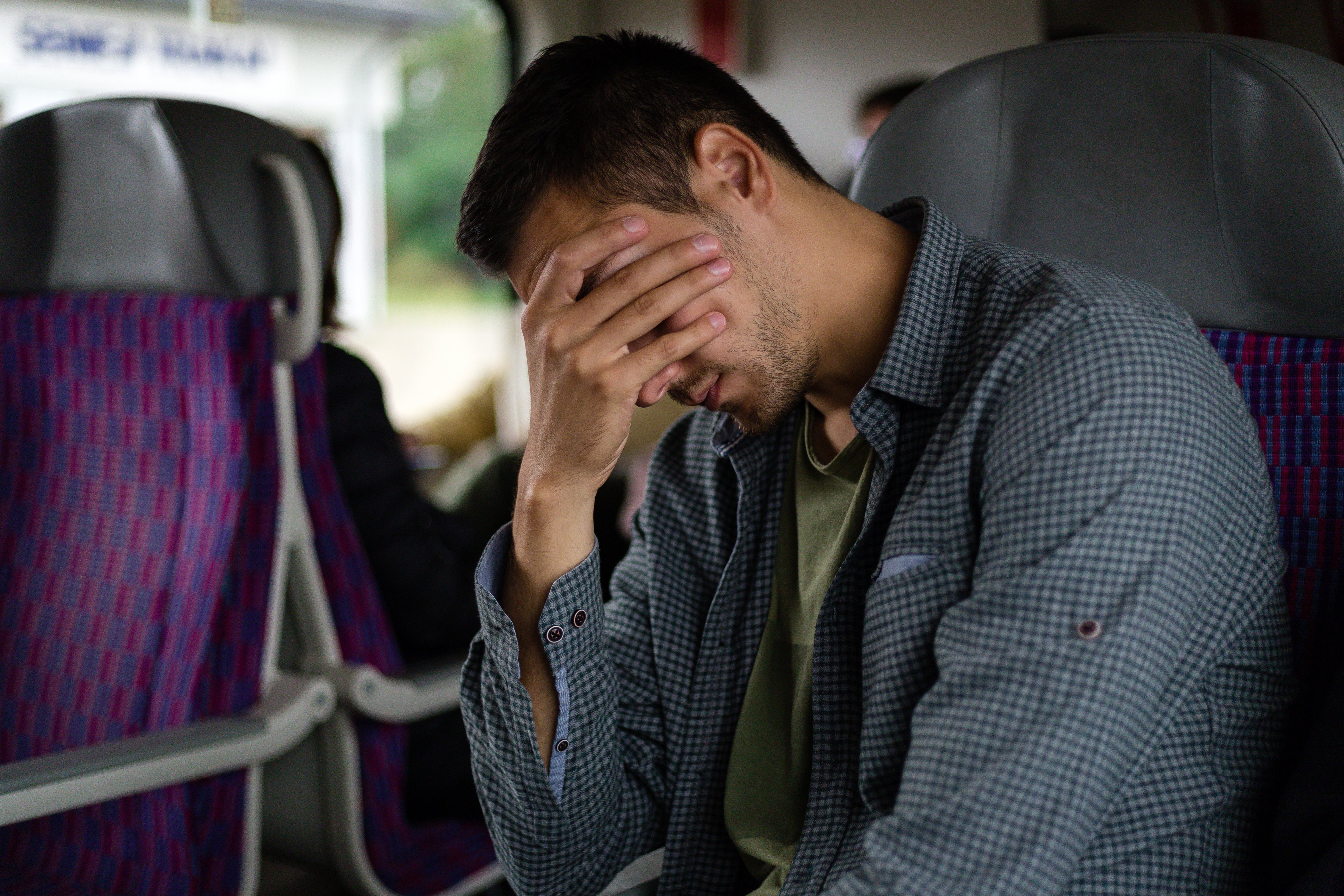
Jarring snatches of sound reverberate through the air as a teen flicks through TikTok at breakneck speed. A toddler stares intently at an episode of Peppa Pig that’s blaring from their tablet for all to hear. Someone is trying to learn French and being spurred on by the coos of the Duolingo owl. The person behind them is yelling into their phone’s loudspeaker, as if they’re attempting to break some bad news to their fellow Apprentice teammates. Is this the ninth circle of hell? Nope, just the quiet carriage of a train chugging through the British countryside on any given day.
OK, I admit: you’d have to be pretty unlucky to encounter all of those nightmarish auditory experiences at once. You’re more likely to face just one or two during the same journey, with the “see it, say it, sorted” announcements acting as a depressing chorus. But as someone who doesn’t drive, and whose friends and family are now scattered across the country, I spend a decent chunk of time and money traversing the UK’s railways. Typically, motivated by some pointless mixture of optimism and naivety, I opt for the quiet carriage. And over the past couple of months, I’ve been rewarded for that optimism and naivety with every single one of the above scenarios.
Thanks to some topsy-turvy logic, the quiet carriage seems to have become the most chaotic part of the train. There are a few problems at play here. First is the fact that one person’s “quiet” is another person’s “migraine-inducingly irritating” – we all have our own, highly subjective ideas about what constitutes appropriate behaviour. Then there’s the necessity of self-policing, because railway companies aren’t in the position to, say, start employing designated “shush-ers” to stroll up and down, dishing out dirty looks like a zealous librarian. The vast majority of us are too pathologically conflict-averse to consider tapping a loud rulebreaker on the shoulder and asking them to keep it down, even if the flipside involves having to listen to Sandra shouting on speakerphone about what time she reckons we’ll arrive at Runcorn.
But the biggest issue of all, I think, is one of expectation. When you enter a space that is explicitly designated as “quiet”, and then that quickly proves not to be the case, you’re surely going to end up feeling much more annoyed than you would have done if you hadn’t been given a false promise of tranquillity in the first place. Having your hopes raised only for them to be brutally crushed by the tinny sounds of someone else’s Spotify playlist is somehow way worse than having to listen to the second-hand noise of said playlist in the lawless zones of the “loud” coaches.
It wasn’t always this way. The quiet carriage became popular in the Nineties and Noughties as a haven from loud phone calls, back when communicating by mobile meant yelling into your chunky handset and hoping that the person on the other end could vaguely make out what you were saying. For a while, they seemed to do the trick, acting as a safe space that was reliably free from noise. So draconian was the atmosphere that I have a very clear memory of being reprimanded for laughing too loudly by a terrifying old woman. I was pretty sure I’d only been giggling at an inoffensive level, but rest assured that my friend and I spent the remainder of our journey in near-silence, for fear of offending this elderly enforcer.
Over the past decade or so, though, things seem to have been on a steady decline. In the mid-2010s, a handful of rail companies announced that they’d be getting rid of their quiet carriages altogether. Their rationale? By this point, using your phone on the train was more likely to mean texting or scrolling through social media than making calls. As quiet carriages became comparatively rare, passengers got rusty on following the rules. So if you did happen to be travelling on a train that had one, chances were that some of your fellow travellers genuinely weren’t aware that they were sat in a space with its own specific etiquette (if you wanted to give them the benefit of the doubt, that is; maybe they just noted the lack of enforcement and decided to run with it).

Since the pandemic, the situation has only got worse: playing videos and music from your phone in public spaces has become a widespread bad habit. It’s proved so contentious that last month, the Liberal Democrats proposed £1,000 fines for so-called “headphone dodgers”. Listening in on someone’s TikTok session can be particularly grating, thanks to the speed and sheer variety of the videos: one second they’re watching a Californian girlie explaining the intricacies of her morning routine, the next it’s a dance sequence set to a disorientingly sped-up Noughties single.
Young people aren’t the only culprits, though. In fact, it’s often their technologically inept elders giving their fellow passengers a headache, thanks to, say, their inability to silence the haptic noises on their phone keypads. Surely we’ve all sat behind someone who insists on turning every single message they send into a tortuously slow dirge of disconnected bleeps and pings that might as well have been precision engineered to raise your blood pressure.
What exactly is the purpose of the quiet carriage, apart from inadvertently enraging us?
It’s enough to leave you asking: what exactly is the purpose of the quiet carriage, apart from inadvertently enraging us? I’ve come to the conclusion that, as much as I want to love them, we’d actually all be better off without them. The term “quiet” is simply too diffuse and subjective. Some people reckon it means recreating the silence of a meditation retreat while trundling through rural England. Others reckon that as long as they’re not actively bellowing or dancing down the aisles to the strains of their own personal boombox, they’re probably all right making a phone call.
This is almost guaranteed to lead to arguments – if the annoyed party is bold enough to raise the issue, that is, rather than just seething in silence (my preferred method). And you know what arguments are? Not particularly quiet.
But the failure of the quiet carriage is also, I reckon, symptomatic of the flaws in our railway system. Our trains are expensive – last year, a study from campaign group Transport & Environment claimed that British rail passengers pay the highest fares in Europe, and in 2019, the Trade Union Congress (TUC) found that prices had increased at twice the speed of wages over the previous decade. They’re also often very busy indeed. In 2023, Department for Transport stats showed that almost 14 per cent of all passengers ended up standing during morning and afternoon peak times.

This creates a perfect storm for dissatisfaction. If there are only, say, five carriages on a packed service and one has been designated as quiet, any spare spots are inevitably going to get filled up by passengers who didn’t opt for a near-silent experience. It’s just not realistic to believe that quietness is going to be enforced. And you can’t really begrudge noise from, say, a family with young kids who’ve found the only free four-person table seat on the train. It’s not really their fault that they’re in your quiet sanctuary. And it’s not their fault that you’ve had to hand over vast amounts of money for the privilege of sitting in a noisy, smelly vehicle that may or may not make an unscheduled half-hour stop just outside of Milton Keynes.
The quiet carriage, then, is a relic from an era when the railways seemed to run better, when passengers were more hung up on following the rules, and when blasting music out loud was a total faux pas. It’s time to admit defeat and ditch them altogether. Next time, you’ll find me grinning and bearing it in the “loud” zone. At least then I’ll be able to keep my expectations lower than low. Anyone got any good recommendations for noise-cancelling headphones?
Anna Camp says relationship with ex Michael Mosley was ‘like a one-night stand’
Harry Potter star ‘scared’ after ‘lurid’ messages sent to her OnlyFans account
Meghan Markle and Prince Harry ‘host’ Brooklyn Beckham and Nicola Peltz in Montecito
Lorde says she’s ‘in the middle gender-wise’ but refuses ‘non-binary’ label
Lala Kent shares ‘terrifying’ health update after pre-cancer diagnosis
Popular influencer Nara Smith accused of ‘glamorizing’ teen pregnancy







